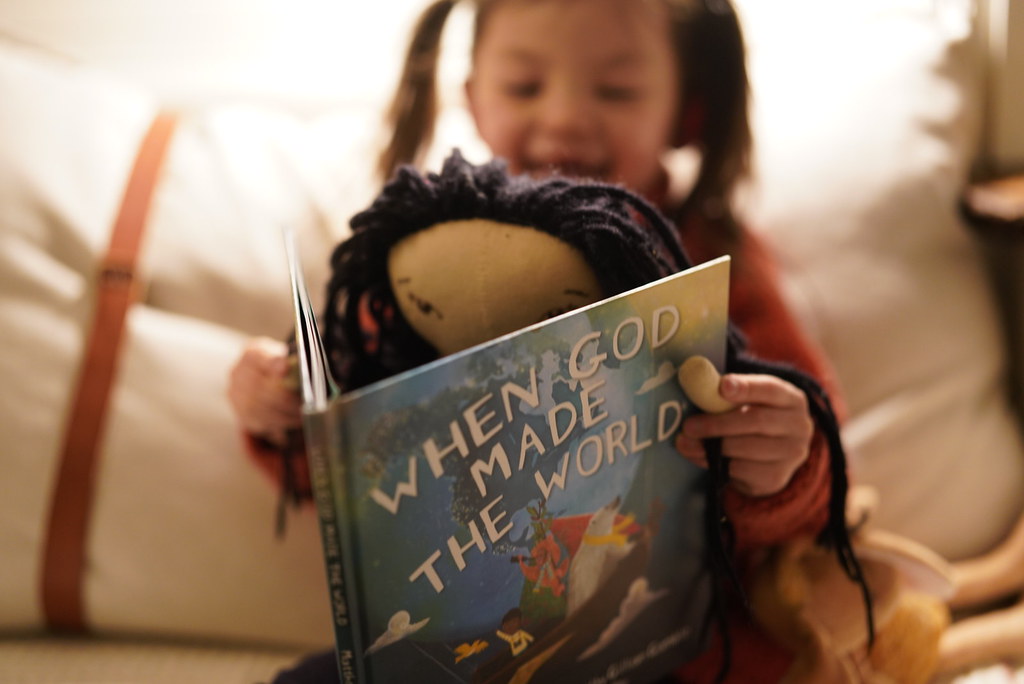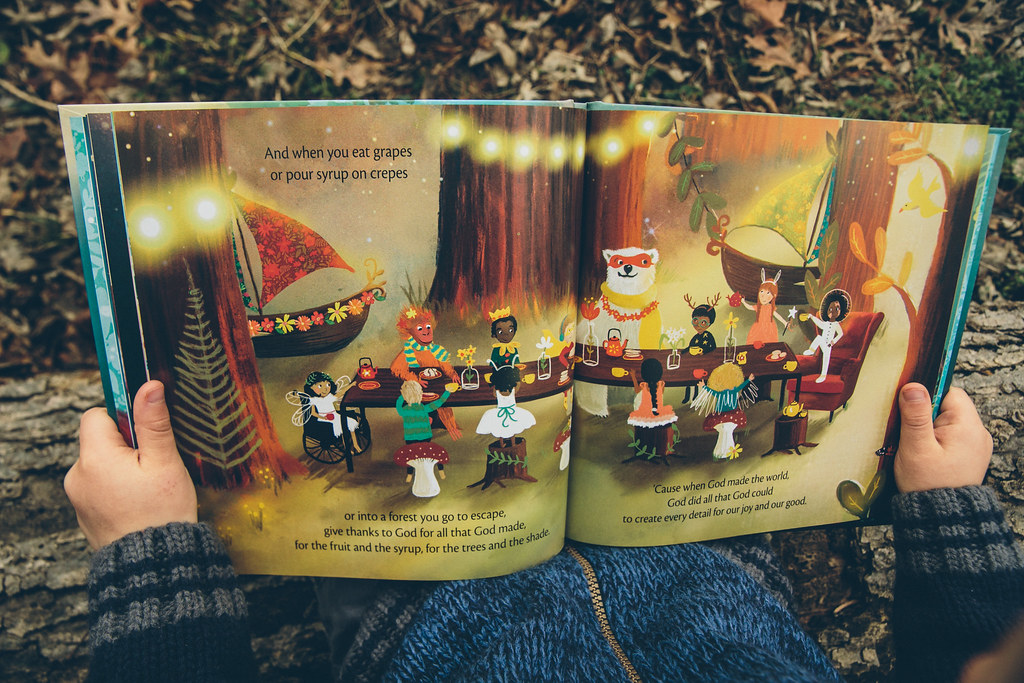For the past five years I have invited my friend Matthew Paul Turner to the farm’s front porch. Today, he’s sharing how we can teach our children about God through the creation story in honor of his gorgeous new book When God Made the World. Shiloh and I have enjoyed it multiple times since reading it. I’m captivated by the many layers Matthew brings to a story we all know well. It will bless your story times tremendously.
guest post by Matthew Paul Turner
In the very beginning, before anything was, before God started doing what it is God does. When all that existed was wide open space, God imagines a universe and began to create…
As a child, few stories sparked my curiosities about God more than the first two chapters of Genesis. Which of course makes sense in a lot of ways.
There’s something about the sheer magnitude of Creation that perfectly describes the bigness and power and mysteries of God.
Every time I heard a Sunday school teacher talk about Creation, I always tried hard to comprehend what it might have been like to see that first glimmer of light or to hear the roar of trees bursting from the ground.
Long after the Sunday school lesson was over, my imagination would still be working overtime, trying to conjure up mental pictures of God creating space and stars, planets and moons, oceans and mountain ranges.
And while the mental pictures that my mind created never came close to revealing the realities of how things began, I realized while writing When God Made the World that many of the things that I love and adore about God today are truths that God revealed in the very beginning, truths that I want my kids to know, truths that I believe all parents of faith hope their kids will learn and hide in their hearts.




Here are four truths that children (and grownups, too) can learn about God from the Creation story.
...Among the stars and planets and cosmic, God made a place for the story of us…
Truth #1: God is with us and has always and will always be with us.
Is there anything more comforting, more mysterious, and more hopeful to people of faith than God’s presence? Isn’t that the core tenet of nearly every story from scripture— from Creation to life and teachings of Jesus – that God is with us.
And while I’ve certainly walked through seasons when I’ve doubted God’s existence, one thing that always jars my heart awake to the presence of God is nature. A forest of pine trees, the crashing waves of an ocean, the beauty and power of a storm—nothing sings of God’s presence like the ever present whir of nature.
And while nature doesn’t answer all the questions we have about God and it doesn’t explain away the very real pain that people experience, it does sometimes help remind us we’re not alone.
I know that for me, few things calm my anxious heart like being outside amid the things that I believe God created. My hope is that one day when my kids are walking through a difficult time, a moment when life’s noise are loud and overwhelming, they’ll know to get outside, that they’ll surround themselves with the constant presence of God that’s growing and moving all around us.



…God made tropics and plateaus, glaciers and meadows, marshes and tundras, and erupting volcanos… God made some places high, with peaks in the sky, and places where snowflakes still fall in July…
Truth #2: God is detail-oriented.
As I got older and began to learn and understand how things worked, I often found myself wishing that the writer of Genesis had offered us more details about how it all happened. And yet, even though the Genesis story isn’t overly flowered with intrigue and description, Creation itself speaks of God not only being present, but present in all of the intricate details of life.
Jesus spoke of God’s attention to detail when He talked about God’s concern for the lily.
During the last couple of springs, my daughter, Adeline, and I planted a few flowers in our front yard. And while I didn’t make every seed we planted a lesson about the nature of God, my hope is that by engaging the simple act of gardening — planting a seed, watering that seed, and watching it grow up — that Adeline began to comprehend how God shows up in the small things of life.
Through gardening and nature we can teach out children that God is not only concerned with big things, but that God also cares about the little things happening in our stories.
Helping our kids know and understand God’s concern for the details of our lives will offer them a multitude of ways to see God’s handiwork in their lives and as well as the world around them.




…God made bluebirds and blackbirds, big birds and small birds, a few birds quite absurd, and the loudest birds you’ve ever heard. Crows crowed, doves cooed, chicken’s clucked, owls booed, robins chirped, pheasants whirred. The world got noisy when God made birds…
Truth #3: God is creative.
One of my favorite parts about Creation is how it showcases God’s creativity, which is such a tangible idea for children to grasp.
That God made Earth to be a biodiverse, color-filled, planet with a rich variety of plant life, wildlife, and climates is something that kids can see, feel and hear.
And people—the world is a family made up of people from all different ethnicities, a reality that should unite us and never put us at odds with one another.
And as people made in God’s image, this idea of God being creative is one way to offer little ones a clear example about how they’re a reflection of God. Moreover, because children spend so much time being creative in art and play, it gives parents and caregivers an easy way to connect their image to God’s image.
That’s something the child in all of us can find hope in—that we are all created in God’s image, a human impression of our Creator.






…Discover a star, a planet, or moon, or help keep a forest from dying too soon. Save a whale, hug a tree, protect every bee. Recycle, repurpose, reject apathy…
Truth #4: God wants us to take care of our planet.
After creating life—plants, animals, birds, and fish—and calling all of these things “good,” God puts humanity in charge of caring for Earth. In fact, taking care of God’s creation is the first human responsibility mentioned in scripture, a responsibility that sadly we as people have often failed to take seriously.
The importance of caring for our planet is such a good and holy gift that we can give to our children.
We need little ones who care about living creatures, who know and understand the importance of rivers, lakes, and farmland, who do not take for granted where our food supply comes from, and who not only take ownership of all that God has given us, but loves and protects and responsibly uses all that God has given us.
…’Cause all of creation whispers God’s story—the mountain, the ocean, the blue morning glory, the raindrops, the sunshine, the grapes on the grapevine. With nature, God gives us a glimpse of divine…
And this is why I decided to write a book about what happened “in the beginning,” to hopefully empower families to fall in love with creation all over again and to play an active role in caring for all the things that God has made.
And too, to give kids (and the kid in all of us) a glimpse of who God is—because few things reflect the beauty and power and glory of God like this beautiful planet that all of us call home.
Matthew Paul Turner has done it again. Like his other children’s books, When God Made the World is full of encouragement, profound truth and hope. It is a book you’ll want to read again and again.








